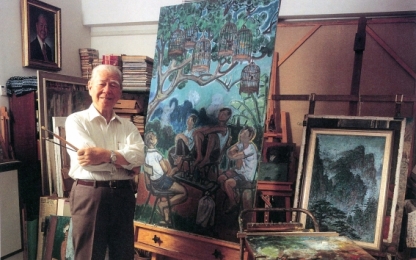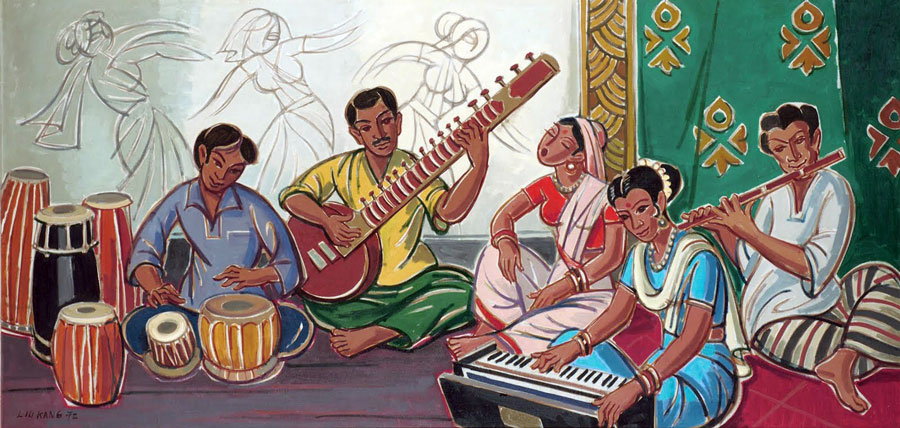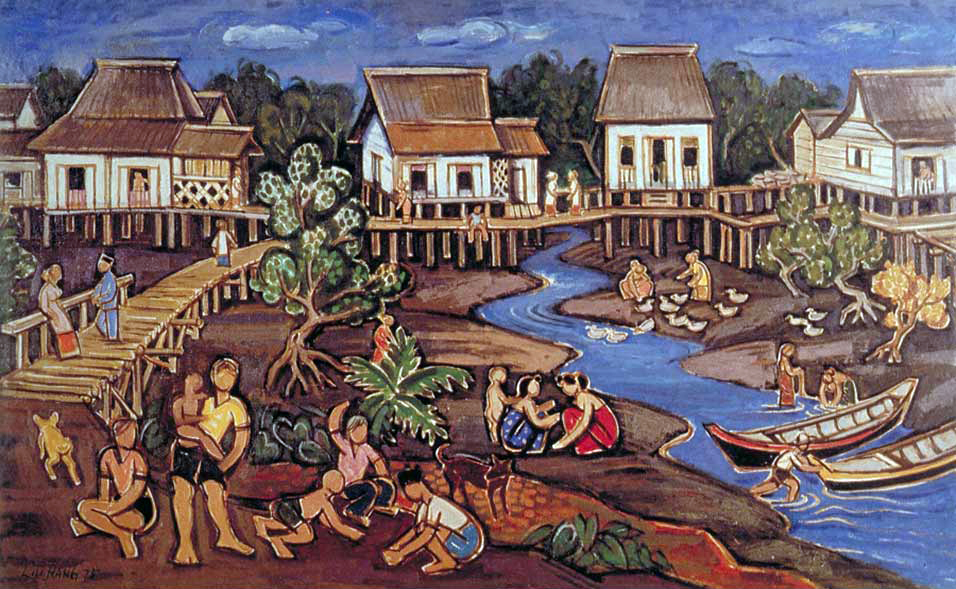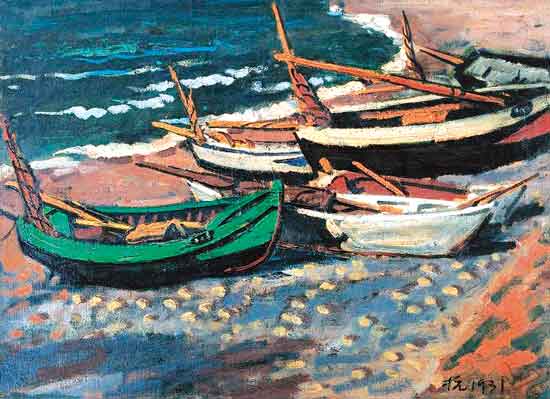|
Born in 1911 in Yongchun,
China, a six-year-old Liu Kang
moved with his family to Muar, Malaya where his father purchased a rubber
plantation. Liu attended Chung Hwa
School and then Chinese High
School in
Singapore, and was sent to China to
continue his secondary school education in Jinan
University
Middle School
in Shanghai.
 During
the school holidays, Liu attended a two-month long art course at the
Shanghai Academy of Fine Arts. Recognising his talent for art, Liu was
allowed to enrol in the academy, starting his formal art education in the
second year of the art programme. At the academy, he learnt much under the
mentorship of his principal Liu Haisu. During this time, he would also
come to know the sister of his fellow artist Chen Jen Hao, Chen Jen Ping,
who would become his wife ten years later. During
the school holidays, Liu attended a two-month long art course at the
Shanghai Academy of Fine Arts. Recognising his talent for art, Liu was
allowed to enrol in the academy, starting his formal art education in the
second year of the art programme. At the academy, he learnt much under the
mentorship of his principal Liu Haisu. During this time, he would also
come to know the sister of his fellow artist Chen Jen Hao, Chen Jen Ping,
who would become his wife ten years later.
Graduating from the academy in 1928
together with Chen Jen Hao, Liu travelled to Paris,
France to further his art
education at the Académie de la Grande Chaumière from 1929 to 1933. In
this new artistically rich environment, he found great inspiration in the
works of Gauguin, van Gogh, Matisse and Cézanne.
Completing his course at the Académie de
la Grande Chaumière, Liu returned to Shanghai and joined the Shanghai
Academy of Fine Arts as its youngest professor, teaching Western Painting.
In 1937, shortly after marrying Chen Jen Ping, Shanghai fell to the
Japanese Invasion and the couple moved to Malaya. For five years, Liu
taught at the Nan Chiau Teachers’ Training
College
and Chung
Cheng
High School in Singapore. When the Japanese army eventually reached
Singapore in 1942, Liu, his wife and Chen Jen Hao immediately moved to
Muar where he opened a coffeeshop with his brother-in-law. In their haste
to avoid the war, Liu left behind many of his paintings in Singapore. To
escape Japanese prosecution of the intelligentsia in Muar, he moved alone
to Singapore soon after to work as a commercial sign painter.

During his time in Malaya,
Liu witnessed war atrocities committed by the Japanese army against
Chinese men, women and children. The memories of what he had seen haunted
him and in 1946, when he moved with his family to Singapore after the
Japanese Occupation was over, he published Chop Suey, a multi-volume book
of illustrations depicting in sometimes graphic detail the horrors that
the Japanese army had inflicted on people in Malaya.
 Back
in Singapore, Liu began serving as the president of the Society of Chinese
Artists, which had a far-reaching membership and influence in Southeast
Asia. He reconnected with old Shanghai
Academy
schoolmates and fellow artists from the society such as Chen Wen Hsi,
Cheong Soo Pieng and Cheng Chong Swee. In 1952, the four of them went on
their historic excursion to Bali
where they stayed for a few months and were greatly rejuvenated and
inspired by the sights, sounds, rhythms and colours of Bali,
resulting in the birth of the Nanyang style of art. Back
in Singapore, Liu began serving as the president of the Society of Chinese
Artists, which had a far-reaching membership and influence in Southeast
Asia. He reconnected with old Shanghai
Academy
schoolmates and fellow artists from the society such as Chen Wen Hsi,
Cheong Soo Pieng and Cheng Chong Swee. In 1952, the four of them went on
their historic excursion to Bali
where they stayed for a few months and were greatly rejuvenated and
inspired by the sights, sounds, rhythms and colours of Bali,
resulting in the birth of the Nanyang style of art.
In 1957, Liu held his first solo
exhibition at the Victoria Theatre Hall. The works showed the artist in a
new phase of maturity, which saw him seeking to represent the experience
of the Chinese diaspora in Southeast Asia. The depiction of local people
laboring or engrossed in ordinary activity was the dominant theme of his
paintings in the ’50s such as Building Site/Samsui Women (1951), Offerings
(1957) and Durian Vendors (1957). His earlier paintings had shown
influences of Post-Impressionism and Fauvism in their expressiveness,
intense colours and form, as well as possible influences of Chinese
painting with their composition and brush strokes. Now, they exhibited
indigenous Southeast Asian influences with their brighter hues, flatter
forms and bold outlines of white.
During
this time, Liu Kang also took up teaching positions at various schools
including Nanyang Girls’ High, Chinese
High School
and Dunman
High School,
of which the principal was his brother-in-law and old friend Chen Jen Hao.
Together with Chen, he designed the
Dunman
High School
school crest.
 He
also travelled for inspiration, visiting Nepal and India. He also wrote
many critical essays on art, expressing his thoughts on art education in
Singapore, art criticism and development. In 1968, he became a founding
member of the Singapore Art Society, and served as its president for 11
years until 1979. He
also travelled for inspiration, visiting Nepal and India. He also wrote
many critical essays on art, expressing his thoughts on art education in
Singapore, art criticism and development. In 1968, he became a founding
member of the Singapore Art Society, and served as its president for 11
years until 1979.
Liu became a respected individual known
for his efforts in promoting art in the community. He contributed his
services as chairman of both the National Day Art Exhibition Committee and
the Visual Arts Advisory Committee for the Ministry of Culture.
An instrumental figure in the development
of the Singapore art scene, Liu Kang was recognised for his many
contributions to art in Singapore. He received the Bintang Bakti
Masyarakat (Public Service Star) in 1970 and the Pingat Jasa Gemilang
(Meritorious Service Medal) in 1996 for his contributions to art in
Singapore.
In 2003, Liu Kang donated what remained
of his life’s work, comprising over 1,000 paintings and sketches, to the
Singapore Art Museum.
The following year, he passed away at the age of 93 in
Singapore.
In 2011, his artistic achievements were
celebrated with a retrospective exhibition Liu Kang: A Centennial
Celebration, organised by the National Art Gallery, Singapore, supported
by the National Heritage Board, and held at the Singapore
Art Museum.
The 100 works, sketches, essays and artefacts on display took audiences
through Liu Kang’s artistic journey from young migrant artist to venerated
artist-educator and national treasure.
|